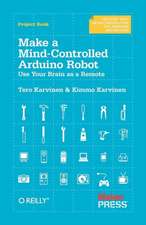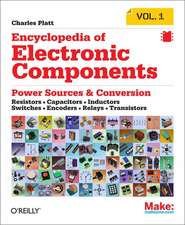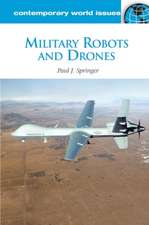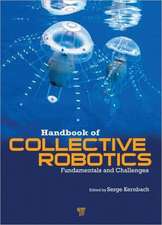Making Robots Smarter: Combining Sensing and Action Through Robot Learning
Editat de Katharina Morik, Michael Kaiser, Volker Klingsporen Limba Engleză Paperback – 11 oct 2012
In terms of the study of embodied intelligence, Making Robots Smarter asks how skills are acquired and where capabilities of execution and control come from. Can they be learned from examples or experience? What is the role of communication in the learning procedure? Whether we name it one way or the other, the methodological challenge is that of integrating learning capabilities into robots.
| Toate formatele și edițiile | Preț | Express |
|---|---|---|
| Paperback (1) | 986.66 lei 6-8 săpt. | |
| Springer Us – 11 oct 2012 | 986.66 lei 6-8 săpt. | |
| Hardback (1) | 993.09 lei 6-8 săpt. | |
| Springer Us – 29 iun 1999 | 993.09 lei 6-8 săpt. |
Preț: 986.66 lei
Preț vechi: 1233.33 lei
-20% Nou
Puncte Express: 1480
Preț estimativ în valută:
188.79€ • 197.12$ • 156.25£
188.79€ • 197.12$ • 156.25£
Carte tipărită la comandă
Livrare economică 04-18 aprilie
Preluare comenzi: 021 569.72.76
Specificații
ISBN-13: 9781461373889
ISBN-10: 1461373883
Pagini: 288
Ilustrații: XIV, 271 p.
Dimensiuni: 160 x 240 x 15 mm
Greutate: 0.41 kg
Ediția:Softcover reprint of the original 1st ed. 1999
Editura: Springer Us
Colecția Springer
Locul publicării:New York, NY, United States
ISBN-10: 1461373883
Pagini: 288
Ilustrații: XIV, 271 p.
Dimensiuni: 160 x 240 x 15 mm
Greutate: 0.41 kg
Ediția:Softcover reprint of the original 1st ed. 1999
Editura: Springer Us
Colecția Springer
Locul publicării:New York, NY, United States
Public țintă
ResearchDescriere
Making Robots Smarter is a book about learning robots. It treats this topic based on the idea that the integration of sensing and action is the central issue. In the first part of the book, aspects of learning in execution and control are discussed. Methods for the automatic synthesis of controllers, for active sensing, for learning to enhance assembly, and for learning sensor-based navigation are presented. Since robots are not isolated but should serve us, the second part of the book discusses learning for human-robot interaction. Methods of learning understandable concepts for assembly, monitoring, and navigation are described as well as optimizing the implementation of such understandable concepts for a robot's real-time performance.
In terms of the study of embodied intelligence, Making Robots Smarter asks how skills are acquired and where capabilities of execution and control come from. Can they be learned from examples or experience? What is the role of communication in the learning procedure? Whether we name it one way or the other, the methodological challenge is that of integrating learning capabilities into robots.
In terms of the study of embodied intelligence, Making Robots Smarter asks how skills are acquired and where capabilities of execution and control come from. Can they be learned from examples or experience? What is the role of communication in the learning procedure? Whether we name it one way or the other, the methodological challenge is that of integrating learning capabilities into robots.
Cuprins
Preface. Part I: Learning in Execution and Control. 1. Introduction to Skill Learning; M. Kaiser, R. Dillmann. 2. Learning Function Approximators; C. Baroglio, et al. 3. Learning Sensor Assisted Assembly Operations; M. Nuttin, H. Van Brussel. 4. Learning and Re-Calibration in Flexible Assembly; M. Nuttin, H. Van Brussel. 5. Contact Estimation for Compliant Motion Control; J. Suárez, et al. 6. Learning Sensor-Based Navigation; J. del R. Millán, C. Torras. 7. Learning to Control a Visual Sensing System; M. Accame. Part II: Learning for Human-Robot Interaction. 8. Learning in Human-Robot Communication; M. Kaiser, et al. 9. Learning to Classify; T. Rauber, M. Barata. 10. Learning a Taxonomy of Failures in Assembly; L. Seabra Lopes. 11. Incremental Signal to Symbol Processing; K. Morik, S. Wessel. 12. Learning Understandable Concepts for Robot Navigation; V. Klingspor, K. Morik. 13. Program Optimization for Real-Time Performance; A. Rieger, V. Klingspor. References. Index.












